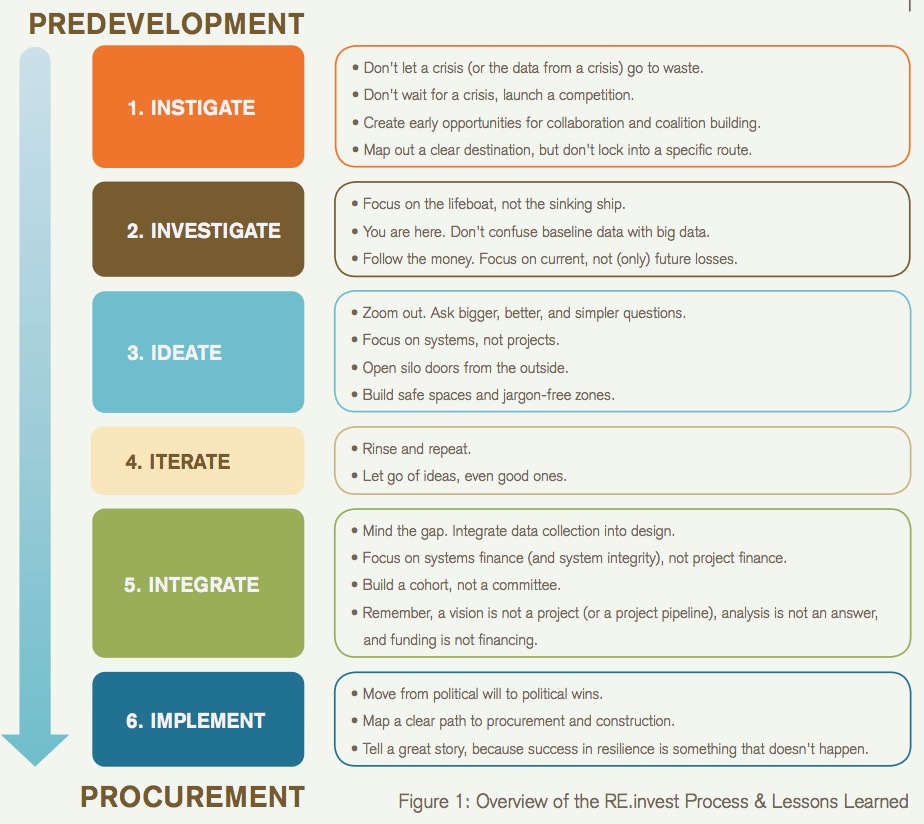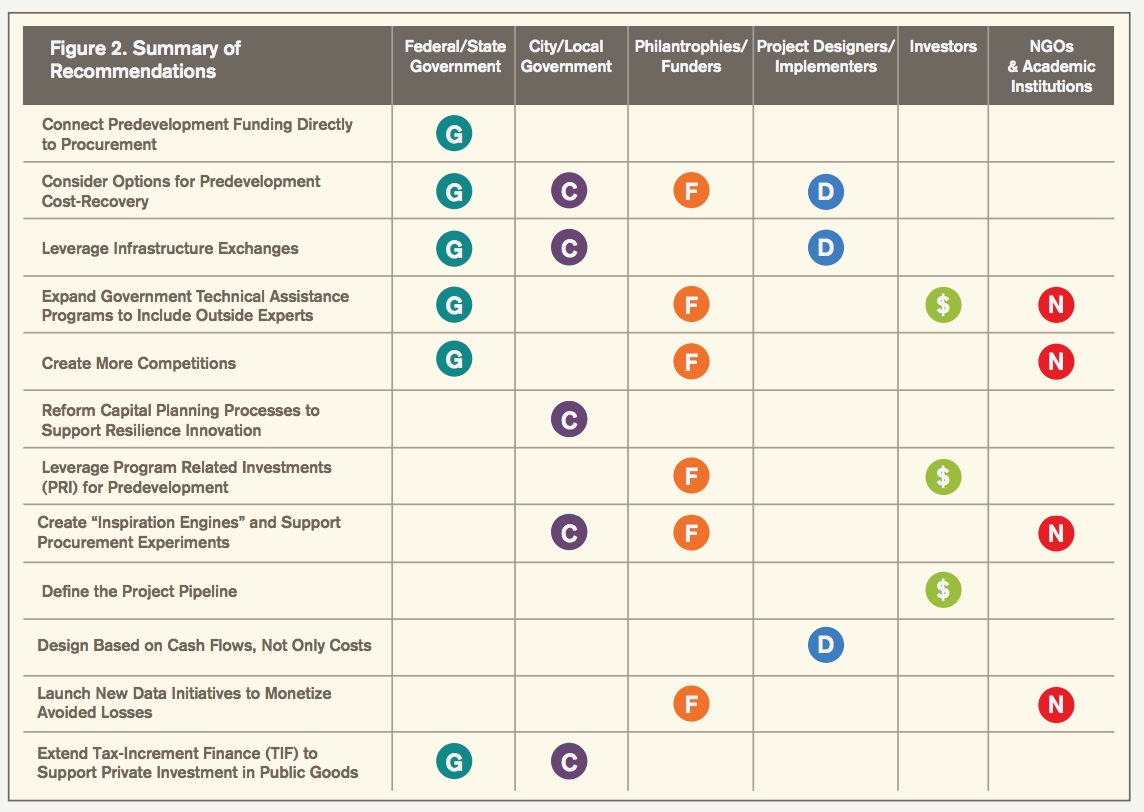THE RE:INVEST INITIATIVE
Introduction
Cities and communities around the world are struggling to finance and replace aging, failing, or inadequate infrastructure systems. Not only are local leaders faced with the challenge of building or rebuilding infrastructure at city-wide scales, they are being asked to do so in a time of strained public resources and greater challenges—like climate change, urbanization, shifting population demographics, and rapid technology change. The American Society of Civil Engineers estimates that US cities need $3.6 trillion dollars in basic infrastructure investment in the next 20 years. This estimate is just to update what cities already have— not to build the smarter, cleaner, greener, and more robust systems designed to address new challenges, like flooding, rising sea levels, heat waves, and more.
We need to think differently about infrastructure.
The future doesn’t look like the past. As budgets for public services continue to shrink, cities large and small need new approaches to providing services and investing in infrastructure upgrades that can meet the demands of the next hundred years, not only the last hundred years. Despite these disturbing trends, there is good news. Political will and leadership abound. Cities across the world are taking charge where state and national politics are deadlocked. In the recovery from the 2008 global financial crisis, leading private sector companies and investors have expressed strong interest in reinvesting in stable assets like roads, power systems, and water infrastructure.
Most importantly, there is growing consensus that we need to act now to not only build infrastructure, but more resilient infrastructure. Still, there is a disconnect between public and private sector interest in expanding infrastructure investment. Currently, political leaders have few incentives to take on projects whose benefits extend beyond their current political cycles. Similarly, investors lack incentives to finance large-scale projects when political turnover is predictable and investment risks are unmanageable. Leaders from both the public and private sectors have called repeatedly for new public-private partnerships. Even with these seemingly aligned goals, large projects have been few and far between and overall infrastructure investment is still lagging.
This report offers a new framework for bridging this gap. As a 2-year national effort launched with the generous support of the Rockefeller Foundation, the RE.invest Initiative tackled the problem of infrastructure predevelopment—all of the activities that go into designing and planning large-scale infrastructure projects prior to construction. This report summarizes the outcomes of RE.invest, an 18-month predevelopment process with eight US cities and teams of leading private sector design, engineering, law, and finance experts. The results are examples of the types of projects made possible using a new framework for reimagining civic infrastructure systems to create both public value and private investment opportunities, especially for vulnerable communities. The concepts and examples developed through RE.invest offer a new approach for public and private sector leaders to forge innovative partnerships to build resilience around the world.
How to Read This Report
This report is designed to inspire a wide range of readers interested in addressing the challenge of creating a robust pipeline of investable resilient infrastructure projects. It captures how RE.invest reimagined the predevelopment process for resilient infrastructure to integrate early design and financing decisions and help cities make the leap from crafting a vision for resilience to generating a set of financeable large-scale projects.
A Framework for Innovation
This document is organized in five main sections. The first lays out the key challenges in urban infrastructure investment and makes the case for investing in resilience. The second presents a new guide for predevelopment using principles of design thinking and systems innovation to address the barriers to resilient infrastructure investment. The third section captures the RE.invest process and the fourth provides an overview of all eight RE.invest partner city solutions.The final section provides recommendations for government officials, developers, financiers, and communities engaged in investing in resilience and reinvesting in communities.
The new framework and recommendations captured in this report can be applied around the world to generate new ideas for re-envisioning communities, infrastructure systems and resilience investment opportunities.
Figure 1 highlights the RE.invest six-step systems approach to predevelopment alongside the major insights and lessons learned at each phase of the process in all eight RE.invest partner cities.
Guidance for Our Readers
Given the number of stakeholders involved in building urban resilience, this report is written for a wide audience with specific recommendations for various institutions summarized in Figure 2. In particular, the Systems Approach section is organized to help governments and philanthropies encourage predevelopment and close the gap between conceptual design and procurement of infrastructure. Similarly, the Partner City Solutions section is intended to inspire designers, project developers, and investors to integrate infrastructure planning across sectors and identify new investment opportunities. Finally, the Guide for Infrastructure Innovation aims to provide these institutions and community-based organizations with new points of entry for enhancing traditional planning and procurement processes in their cities to build greater resilience.
For readers interested in an overarching view of the challenges and opportunities of resilient infrastructure planning, this report offers a high-level description of the RE.invest process and the resulting city-specific solutions. For more technical readers or readers interested in specific local issues, each city solution is expanded in a set of individual city reports (see www.reinvestinitiative.org)
Although all of the featured examples are based in US cities, RE.invest was designed as a springboard to catalyze resilient infrastructure investment around the globe. To this end, the general resilience design concepts outlined in the Activities and Building Blocks (engineering) section are intended to serve as an entry point for any city seeking a new pathway to cross-sector design and finance innovation.
Download full version (PDF): A Roadmap for Resilience
About the RE:Invest Initiative
www.reinvestinitiative.org
The RE.invest Initiative is a collaboration among eight partner cities and leading engineering, law, and finance firms to create new public-private partnerships for resilient infrastructure. Cities across the country are facing serious challenges in rebuilding their aging water, energy, and transportation systems. RE.invest is designed to help cities develop more flexible, sustainable, and integrated networks and use public resources more efficiently to leverage private investment in building stronger communities.
Tags: RE:Focus Partners, RE:Invest Initiative, Rockefeller Foundation








 RSS Feed
RSS Feed